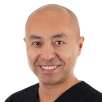With his high-definition photography of complex root canal systems, Dr. Craig Barrington, who practices dentistry in Waxahachie, Texas, is developing quite a name for himself. Just check out his presence on Facebook, at craiggbarringtondds. In an interview with Endo Tribune, Barrington talks about how he captures these high-definition endodontic images and how he uses them to increase his knowledge and help improve the level of care he provides to his patients.
Please tell our readers a little bit about yourself and your dental practice.
I graduated summa cum laude from the University of Texas Health Science Center in San Antonio in 1996. I am a general dentist in Waxahachie, Texas. I have been in my current location for 20 years.
What do you like best about practicing dentistry?
I most enjoy the science, the biology and having a front-row seat in and around the ability to interact with, affect and watch the human body function and heal. I appreciate the ability to solve problems and the ability to work on problems that are yet to be solved. I like being a part of a “past, present and future” continuum that is the overall profession of dentistry. I enjoy having the ability to affect an individual person, from patient to fellow practitioner to dental student, all the way up to having the ability to have a positive effect on humanity across the globe.
Who influenced you most in your career?
First, I would thank Dr. Joel B. Alexander. He was an endodontic professor when I was in dental school who encouraged and taught the value of recalling your cases in order to assess your treatment outcomes.
Secondly, I would thank Dr. Terry Pannkuk. After much awareness, pursuit of and concentration on the topic of mentorship, I certainly believe he is the best doctor alive today. He has done much for our profession from a philosophical standpoint to the actualities of clinical health care. He sees the value in this tooth clearing and diaphonization project I am involved in and consistently has provided more support and encouragement than anyone else. He has kept me motivated even if it is just by simply saying, “Wow, that result is amazing.” I can’t say enough about what he has done for me personally or in my career as my friend and mentor. I continue to learn from him daily, and I hope that somewhere along the way, I reciprocate some of the support he has given me over the years.
embedImagecenter("Imagecenter_1_2572",2572, "large");
You have become known for your high-definition photography of the root canal anatomy. How did you become interested in this area?
That too goes back to Dr. Alexander and Dr. Pannkuk. Both of these doctors influenced me to recall my work in endodontics and truly take a scientific approach to the question of whether endodontics actually works and whether it actually works in my hands. After recalling many of my own cases, I started to see failures and problems that I was not satisfied with. I started to postoperatively evaluate my work and found that there were clinical aspects I could change to improve my outcomes. It was via the internet that I met Dr. Arnaldo Casteallucci. After the interactions we had, I saw the cover of his textbook.
The tooth on the cover put me in awe. This was the first “cleared tooth” I had ever seen. It is from there that my interest in clearing teeth originated. I just had to figure out what was going on and how and why it worked. Fifteen years later, I am still manipulating processes in the diaphonization of human teeth in search of the “answers.” I have a patent pending in the clearing process, and the knowledge it has provided has become one of the most valuable tools in pre-operative and post-operative evaluation of the internal anatomy of human teeth.
Can you tell our readers a little bit about how you go about capturing these images? It must take some technical skill.
The photography is actually not difficult. It is oil immersion oblique illumination light microscopy, which has been done in histology labs for years. It is, however, a new realization in this area for dentistry. In dentistry, we are familiar with the study of microscopic histologic sections. Teeth, on the other hand, are gross histologic specimens that can understandably be seen via the naked eye; however, viewing of the internal anatomic structures is greatly enhanced with microscopic evaluation. Any photographs of the teeth I work with are simply obtained through my “artistic” arrangement of the specimen in either a visually interesting position or in what I would consider an educational interpretation that I think would most benefit the viewer of the photograph.
What have you learned most by taking these root canal photographs?
As Napoleon Hill said, “Whatever your mind can conceive and believe, it can achieve.”
Where I sit today in my understanding of tooth clearing and diaphonization, I at first thought was never possible. It started as a simple question, then the development and realization of a goal. The process has been consistently evolving and delivering information and results ever since.
Today, I see characteristics of the internal anatomy of human teeth that I never thought possible or knew existed. Visualizing the immense variability of human tooth anatomy has changed my clinical practices and improved my clinical results, which benefits the patients I treat.
Do you perform endodontic therapy yourself or do you typically refer cases out?
I do all of my own endodontic treatments in my office. It has taken me years to identify the area of dentistry that I love. Perhaps one day I will take the necessary steps to specialize, but life is currently focused on my family and my children.
Is there anything you would like to see changed about the way dentistry is practiced today?
Absolutely! More than you can imagine or can be covered in this session. In short, we need to work on our ethical standards within the profession itself and move back toward being true, real doctors over the business-focused patient treatment we are seeing overwhelm the practice environment today.
The actual care of the patient is always in competition with and in direct contrast to the business and profit. We have to get back to patient-centered practices. The profits are there in mass quantities if we can just take the time to follow our roles as doctors. Doctor by definition means “to teach,” and proper teaching is not going to take place via advertising. Marketing is one aspect. Advertising is another. We have to start the movement toward patient-centered treatment, with the true health care providers taking the first step away from any notion of what would or could be considered advertising in health care.
Is there anything you would like to add?
I am respectfully honored by this opportunity, your questions and in you finding significance in this work of mine. Thank you!
Craig Barrington received his DDS from the University of Texas Health Science Center San Antonio in 1996 and is a member of Omicron Kappa Upsilon. He is also an associate member of the American Academy of Endodontists. He maintains a practice in Waxahachie, Texas. He has written various articles and publications on the dental operating microscope in general dentistry. For comments, questions or presentation requests, please contact Barrington at cbdds002@yahoo.com.
A new book, “An Atlas of Human Dental Vascularity & Innervation,” by Craig Barrington, DDS, will be released in January by Quintessence Publishing Co. ...
At the annual meeting of the Channel3 group of key opinion leaders, held this year in June in Bologna in Italy, the fourth P-I Brånemark Award for Lifetime...
One day I was chatting with Dr Lorin Berland, and he mentioned how much outsourcing his human resources has saved his sanity. As this was something I was ...
We buy “New Tech” when we perceive that some part of our personal or professional lives could be managed more easily with this new tool. We ...
Canals come in all sizes and shapes. They can be any combination of wide, straight, narrow, curved, smooth, gritty, filled with tissue, devoid of tissue, ...
By far the most frequently asked question in every orthodontic office is, “When are my braces coming off?” In the fast-paced, busy lives of ...
A hallmark of the most successful modern clinicians is the ability to strike a balance between a daily load of 12 to 16 patients and maintaining the same ...
CORVALLIS, Ore., USA: A few years from now, millions of people around the world might be walking around with an unusual kind of glass in their mouth, and ...
Dentists are always interested in learning about ways to improve the care they provide their patients. At lectures and hands-on workshops across the ...
Samuel O. Dorn, DDS, received the American Association of Endodontists’ highest honor, the Edgar D. Coolidge Award, given for leadership and exemplary...
Live webinar
Wed. 17 April 2024
10:00 AM EST (New York)
Live webinar
Wed. 17 April 2024
12:00 PM EST (New York)
Dr. Alexander Nussbaum Head of Scientific & Medical Affairs, Philip Morris GmbH, Dr. Björn Eggert
Live webinar
Wed. 17 April 2024
6:00 PM EST (New York)
Dra. Gabriella Peñarrieta Juanito
Live webinar
Thu. 18 April 2024
11:00 AM EST (New York)
Live webinar
Mon. 22 April 2024
10:00 AM EST (New York)
Prof. Dr. Erdem Kilic, Prof. Dr. Kerem Kilic
Live webinar
Tue. 23 April 2024
1:00 PM EST (New York)



 Austria / Österreich
Austria / Österreich
 Bosnia and Herzegovina / Босна и Херцеговина
Bosnia and Herzegovina / Босна и Херцеговина
 Bulgaria / България
Bulgaria / България
 Croatia / Hrvatska
Croatia / Hrvatska
 Czech Republic & Slovakia / Česká republika & Slovensko
Czech Republic & Slovakia / Česká republika & Slovensko
 Finland / Suomi
Finland / Suomi
 France / France
France / France
 Germany / Deutschland
Germany / Deutschland
 Greece / ΕΛΛΑΔΑ
Greece / ΕΛΛΑΔΑ
 Italy / Italia
Italy / Italia
 Netherlands / Nederland
Netherlands / Nederland
 Nordic / Nordic
Nordic / Nordic
 Poland / Polska
Poland / Polska
 Portugal / Portugal
Portugal / Portugal
 Romania & Moldova / România & Moldova
Romania & Moldova / România & Moldova
 Slovenia / Slovenija
Slovenia / Slovenija
 Serbia & Montenegro / Србија и Црна Гора
Serbia & Montenegro / Србија и Црна Гора
 Spain / España
Spain / España
 Switzerland / Schweiz
Switzerland / Schweiz
 Turkey / Türkiye
Turkey / Türkiye
 UK & Ireland / UK & Ireland
UK & Ireland / UK & Ireland
 International / International
International / International
 Brazil / Brasil
Brazil / Brasil
 Canada / Canada
Canada / Canada
 Latin America / Latinoamérica
Latin America / Latinoamérica
 China / 中国
China / 中国
 India / भारत गणराज्य
India / भारत गणराज्य
 Japan / 日本
Japan / 日本
 Pakistan / Pākistān
Pakistan / Pākistān
 Vietnam / Việt Nam
Vietnam / Việt Nam
 ASEAN / ASEAN
ASEAN / ASEAN
 Israel / מְדִינַת יִשְׂרָאֵל
Israel / מְדִינַת יִשְׂרָאֵל
 Algeria, Morocco & Tunisia / الجزائر والمغرب وتونس
Algeria, Morocco & Tunisia / الجزائر والمغرب وتونس
 Middle East / Middle East
Middle East / Middle East
:sharpen(level=0):output(format=jpeg)/up/dt/2024/04/Study-points-to-lack-of-formal-education-on-cannabis-in-dentistry.jpg)
:sharpen(level=0):output(format=jpeg)/up/dt/2024/04/Immediate-full-arch-zirconia-implant-therapy-utilising-the-power-of-robotic-assistance-and-digital-scanning_Fig-1-preophoto_title.jpg)
:sharpen(level=0):output(format=jpeg)/up/dt/2024/04/Lowcost-tooth-sensitivity-liquid-found-to-combat-caries-1.jpg)
:sharpen(level=0):output(format=jpeg)/up/dt/2024/04/DS-Academy-launches-Indirect-Restorative-Course-Series.jpg)
:sharpen(level=0):output(format=jpeg)/up/dt/2024/03/The-fight-continues-for-anaesthesia-safety-in-dentistry.jpg)








:sharpen(level=0):output(format=png)/up/dt/2011/07/fdi.png)
:sharpen(level=0):output(format=png)/up/dt/2019/04/logo.png)
:sharpen(level=0):output(format=png)/up/dt/2023/11/Patent%E2%84%A2-Implants-_-Zircon-Medical.png)
:sharpen(level=0):output(format=png)/up/dt/2014/02/Du%CC%88rr_Dental.png)
:sharpen(level=0):output(format=png)/up/dt/2014/02/A-dec.png)
:sharpen(level=0):output(format=png)/up/dt/2022/01/Ivoclar_Logo_19-01-2022.png)
:sharpen(level=0):output(format=jpeg)/up/dt/e-papers/330729/1.jpg)
:sharpen(level=0):output(format=jpeg)/up/dt/e-papers/330727/1.jpg)
:sharpen(level=0):output(format=jpeg)/up/dt/e-papers/330725/1.jpg)
:sharpen(level=0):output(format=jpeg)/up/dt/e-papers/325039/1.jpg)
:sharpen(level=0):output(format=jpeg)/up/dt/e-papers/325007/1.jpg)
:sharpen(level=0):output(format=jpeg)/up/dt/e-papers/313543/1.jpg)
:sharpen(level=0):output(format=jpeg)/up/dt/2017/01/548c1e840dc447bc4ba29e4ce88b2d8f.jpg)

:sharpen(level=0):output(format=jpeg)/up/dt/2024/04/Study-points-to-lack-of-formal-education-on-cannabis-in-dentistry.jpg)
:sharpen(level=0):output(format=jpeg)/up/dt/2017/12/Michmershuizen-e1514494659544-300x282.jpg)
:sharpen(level=0):output(format=jpeg)/up/dt/2021/12/00_Barrington_new.jpg)
:sharpen(level=0):output(format=jpeg)/up/dt/2018/08/Branemark-Award-recipient-2018-Dr-Michael-Cohen.jpg)
:sharpen(level=0):output(format=jpeg)/up/dt/2021/08/placeholder.jpg)
:sharpen(level=0):output(format=jpeg)/up/dt/2017/01/6ac3b524c70a99bcca3c299eb4160c06.jpg)
:sharpen(level=0):output(format=jpeg)/up/dt/2010/11/f52058c06302cb1713ff292f6ad9a413.jpg)
:sharpen(level=0):output(format=jpeg)/up/dt/2017/01/7501017054d25df6288132658b0eba97.jpg)
:sharpen(level=0):output(format=jpeg)/up/dt/2017/01/39e2bf3405f899ef75fe83c3236dfbd4.jpg)
:sharpen(level=0):output(format=jpeg)/up/dt/2017/01/814bb8c6e3b6135ee1d3d330357e28ad.jpg)
:sharpen(level=0):output(format=jpeg)/up/dt/2009/11/20012b169fa690b4eae5c74441d00ec8.jpg)
:sharpen(level=0):output(format=jpeg)/up/dt/2013/08/ab7cf366f2c218f45b776d25118d9fd2.jpg)







:sharpen(level=0):output(format=jpeg)/up/dt/2024/04/Study-points-to-lack-of-formal-education-on-cannabis-in-dentistry.jpg)
:sharpen(level=0):output(format=jpeg)/up/dt/2024/04/Immediate-full-arch-zirconia-implant-therapy-utilising-the-power-of-robotic-assistance-and-digital-scanning_Fig-1-preophoto_title.jpg)
:sharpen(level=0):output(format=jpeg)/up/dt/2024/04/Lowcost-tooth-sensitivity-liquid-found-to-combat-caries-1.jpg)
:sharpen(level=0):output(format=jpeg)/up/dt/e-papers/330727/1.jpg)
:sharpen(level=0):output(format=jpeg)/up/dt/e-papers/330725/1.jpg)
:sharpen(level=0):output(format=jpeg)/up/dt/e-papers/325039/1.jpg)
:sharpen(level=0):output(format=jpeg)/up/dt/e-papers/325007/1.jpg)
:sharpen(level=0):output(format=jpeg)/up/dt/e-papers/313543/1.jpg)
:sharpen(level=0):output(format=jpeg)/up/dt/e-papers/330729/1.jpg)
:sharpen(level=0):output(format=jpeg)/up/dt/e-papers/330729/2.jpg)
:sharpen(level=0):output(format=jpeg)/wp-content/themes/dt/images/3dprinting-banner.jpg)
:sharpen(level=0):output(format=jpeg)/wp-content/themes/dt/images/aligners-banner.jpg)
:sharpen(level=0):output(format=jpeg)/wp-content/themes/dt/images/covid-banner.jpg)
:sharpen(level=0):output(format=jpeg)/wp-content/themes/dt/images/roots-banner-2024.jpg)
To post a reply please login or register